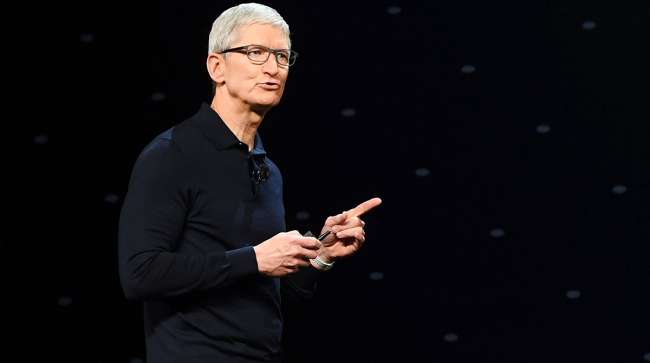Is Apple Making a Cool Car or Just Dabbling With the Tech?

SAN FRANCISCO — In a few weeks, Apple will unveil its newest iPhone.
Stifle that yawn, people.
If the Cupertino, Calif., magic factory truly wanted to once again dazzle audiences at its annual fall event, that category-redefining reveal would involve someone saying, “Siri, bring me my car.”
Long rumored and finally acknowledged last year by CEO Tim Cook as “the mother of all AI projects,” Apple’s iCar mission — dubbed Project Titan — was given a boost last week when analyst Ming-Chi Kuo predicted in an investor note that Apple would double its market cap to $2 trillion on the back of a “star product” car launch in just five years.
RELATED: Former chief Tesla vehicle engineer Doug Field returns to Apple
Kuo singled out Apple’s mastery of software and hardware integration, and added that its burgeoning services business — now the No. 2 revenue generator for the company — fits in perfectly for a captive auto audience.
With a coming mobility shift that experts say will be as radical as ditching horses for the Model T, it makes sense Apple would want to spend some of its $260 billion cash stash on owning a piece of this transportation-as-a-service pie.
But an Apple automobile raises as many questions as possibilities.
These range from whether the company would make its own vehicle as Tesla has done (memo to Cook: prepare to sleep on the factory floor) to whether it would partner with manufacturers to expedite progress (such as Google’s Waymo unit integrating its technology into Fiat Chrysler minivans).
Whatever route Apple takes toward an automotive product, expect secrecy to remain a key ingredient. Apple declined to comment for this story.
“That’s the cult of Apple; they won’t reveal much, then land with a sledgehammer product you couldn’t even imagine 10 minutes before it hit the stage,” Cox Automotive Executive Publisher Karl Brauer said. “It’s who they are.”
Legions Are at Work on the Car
Apple may not be saying much about Project Titan, but it’s more than evident that the company is committing significant resources to the endeavor.
Just last month, a Chinese-born Apple engineer was stopped at San Jose’s airport by the FBI and charged with stealing self-driving car secrets from his employer. A complaint related to the case revealed that around 5,000 of Apple’s 130,000 employees were “disclosed on the project,” and half were core to the effort.
More evidence of Apple’s auto research comes from California Department of Motor Vehicle officials, who report that Apple has received permits to test 66 vehicles — Lexus RX450h SUVs with self-driving sensors — with 121 employees approved as safety drivers.
And while in 2016 staffing turmoil suggested Project Titan could be put on the back burner, reports this month noted that Apple had regained the services of onetime employee Doug Field, who has spent the past five years as Tesla’s senior vice president of engineering.
So the question is: What exactly are these people working on? Analyst Kuo is convinced it is an Apple-branded vehicle, in part because technology increasingly defines a car and automakers come up short in that department.
“Apple can do a better integration of hardware, software and services than current competitors in the consumer electronics sector and potential competitors in the auto sector,” Kuo wrote.
But longtime Apple watcher Gene Munster of Loup Ventures said pump the brakes.
Munster puts the odds of an Apple Car at 30% and a timeline at 10 years — he said 2028 is when 50% of the U.S. transportation market will be made up of autonomous ride-hailing vehicles, something Google-owned Waymo is pioneering in Phoenix.
Instead, Munster is betting that Apple focuses on powering a new mobility experience, working with car companies to provide everything from self-driving car guidance systems to app-related experiences for passengers.
“It’s more likely that Apple will be the brains behind autonomy and in-car services, working with existing manufacturers to either build cars for sale or to power an autonomous fleet,” he said. “If they do [build their own car], it would most likely be sold to consumers as the primary business model.”
Lessons From Tesla
And that raises a series of red flags, many of which Tesla has experienced. Building a car is not easy, with considerations that include lagging suppliers, union recruiting and finding a proper robot-to-human assembly line ratio.
There also are the hurdles that come with complex state-by-state dealership regulations, which can deny manufacturers the opportunity to sell their cars directly to consumers. Tesla sells its cars online and through its stores, where in some states cars are marked with “Not for sale” signs.
That’s why Brauer is convinced Apple would choose not a sales but a subscription model for its cars.
This increasingly popular way to get access to cars, bikes and now scooters on-demand — especially among millennials who have grown up with Uber — could be a $1 trillion business by 2030, according to Cox Automotive.
Some traditional automakers are experimenting with this approach, typified by the Porsche Passport program that grants access to 22 models for $3,000 a month.
“A big stumbling block for any car company is retail, but if you have a subscription model all those [dealer] franchise laws go away,” Brauer said. “A generation has grown up paying a monthly fee for cellphones, internet, streaming movies. That primes the pump for Apple to jump in with an on-demand car service.”
Or maybe it just makes it easy for Apple to provide an existing automaker’s fleet with the kind of Apple-branded service goodies that lure consumers, said Tim Bajarin, president of market research firm Creative Strategies. That would echo Waymo’s approach of placing its tech stack inside cars.
“Do you create a piece of hardware, a car, that has limited numbers and is tied to your services, or do you create the next big service infrastructure that can be retrofitted to all cars?” Bajarin asked, adding that the answer can be gleaned from the original iPod.
“When that device came out, only Apple computer users could enjoy it, but the minute it was opened up to Windows users, sales skyrocketed,” he said.
Bajarin noted that beyond in-car connectivity and entertainment options — which mushroom once cars don’t need drivers — Apple also could leverage the work it is doing on augmented reality to perhaps create a “smart dashboard” that can interact with passengers.
“The next big battleground for tech is about bringing your lucrative services and features inside a car, as opposed to creating your own car brand,” he said.
Can Apple Play Nice With Others?
But taking that approach will require Apple to collaborate with one or more auto manufacturers and possibly other tech companies, a prospect that seems antithetical to a company that long has been known for going it alone.
“Very few companies can do this on their own, which is why partnerships are key when you have a challenging technical problem” such as self-driving cars, said Jack Weast, chief systems architect for Intel’s autonomous driving division.
Intel, which recently bought auto-vision company Mobileye, is focused on growing the numbers of cameras on cars to improve mapping tech for autonomous cars.
Weast said three big hurdles remain before Apple and any other company considers the self-driving puzzle solved: flawless sensors, improved and updatable mapping tech and improved computer testing to guarantee safety. This last hurdle looms large after a self-driving Uber car killed a pedestrian in Tempe, Ariz. in March.
For the moment, Weast sees OEM cars laden with driver-assist features — such as sophisticated cruise control and lane-keeping tech — as offering the biggest growth opportunity for tech companies and automakers alike.
But given its track record, Apple likely wouldn’t be interested in simply offering tech tweaks to existing cars. Its standard operating procedure is to enter an existing market late, but with a blockbuster product.
After all, it was late to the MP3 game, but Steve Jobs tossed a grenade into the market with his iPod and its “1,000 songs in your pocket” pitch. Apple was late to the cellphone party, then blew it up in 2007 with the first iPhone. And so on.
So perhaps that forthcoming fall Apple event that reveals a shiny (white? it was Jobs’ favorite iPhone color) car isn’t that far-fetched after all.
“They have so much money that they can do anything they want: Come in now, come in later, it really doesn’t matter,” said Bruce Belzowski, managing director of research group Automotive Futures.
“Shareholders will want them to do something that makes sense, but given the products they have created in the past it is very tempting to see what they’ll come up with on the automotive front, from the sensors to the experience to maybe the car itself,” he said. “Apple should be a part of this mobility shift, and what part of it is up to them.”
Distributed by Tribune Content Agency, LLC


